Photographs: Reuters Shankar Acharya
In the 60 years since 1950 Indian agriculture has recorded an average growth rate of 2.7 per cent per year.
In the past 30 years, the rate has crept slightly above 3.0 per cent, well short of the 4.0 per cent target set in successive recent Five-Year Plans.
Most analysts infer that it would take great good luck (with weather) or a sweeping revolution in policy design and implementation to achieve and sustain 4.0 per cent growth. Is that really so?
. . .
Agriculture: What others must learn from Gujarat!
Image: Gujarat Chief Minister Narendra Modi.Photographs: Sanjay Sawant/Rediff.com
For a more optimistic answer let's look at the variation in agricultural performance across India's 20 largest states (by population) in the last.
It's striking that agriculture in seven sizeable states (Gujarat, Chhattisgarh, Rajasthan, Maharashtra, Andhra Pradesh, Madhya Pradesh and Orissa) grew faster than 4.0 per cent between 2000-01 and 2007-08. And that fact doesn't change when the relatively bad agricultural years of 2008-09 and 2009-10 are included.
What's more, most of these states are more water-stressed than average. The star performer is semi-arid Gujarat, clocking eight per cent (nearly triple the national average) agricultural growth over the decade.
. . .
Agriculture: What others must learn from Gujarat!
Photographs: Reuters
So let's dig a little deeper into the reasons behind Gujarat's stellar agrarian success, especially as it comes after the decade of the nineties when growth averaged less than 5.0 per cent.
| AGRICULTURE GROWTH (GROSS VALUE ADDED) ACROSS INDIAN STATES (Percentage) | |||
| 2000-01 2007-081 | 2000-01 2009-102 | Sectoral share of agriculture in state GSDP* (2007-08)1 | |
| Gujarat | 11.7 | 8.0 | 16.0 |
| Chhattisgarh | 9.4 | 6.7 | 17.0 |
| Rajasthan | 5.8 | 3.5 | 23.9 |
| Maharashtra | 5.6 | 4.0 | 13.0 |
| Andhra Pradesh | 5.6 | 4.7 | 22.4 |
| Madhya Pradesh | 5.5 | 6.2 | 24.2 |
| Orissa | 4.6 | 4.8 | 23.3 |
| Himachal Pradesh | 4.0 | 1.6 | 19.4 |
| Jammu and Kashmir | 3.6 | 3.1 | 24.1 |
| Haryana | 3.6 | 3.4 | 21.0 |
| Uttarakhand | 2.5 | 2.2 | 16.1 |
| Tamil Nadu | 2.5 | 2.0 | 12.2 |
| Punjab | 2.4 | 2.2 | 31.7 |
| West Bengal | 2.1 | 2.0 | 18.5 |
| Uttar Pradesh | 1.7 | 1.8 | 27.3 |
| Bihar | 1.5 | 1.1 | 23.0 |
| Karnataka | 1.2 | 0.6 | 15.4 |
| Kerala | 0.7 | 0.9 | 12.4 |
| Assam | 0.5 | 1.6 | 24.6 |
| Jharkhand | -0.7 | 1.1 | 8.6 |
| (1) Based on national income data at 1999-2000 prices (2) 1999-2000 prices data up to 2007-08 and 2004-05 base data for growth in 2008-09 and 2009-10 *Gross state domestic product Source: Central Statistical Organisation | |||
The story is persuasively documented in the recent monograph compiled by Indian Institute of Management, Ahmedabad, professors Ravindra Dholakia and Samar Datta: High Growth Trajectory and Structural Changes in Gujarat Agriculture (Macmillan, 2010).
. . .
Agriculture: What others must learn from Gujarat!
Photographs: Reuters
Broadly speaking, professors Dholakia, Datta et al (henceforth, DDEA) identify six factors that were given a concerted push by the Gujarat government from 2002-03 onwards:
- A sustained programme of water conservation and management;
- A massive and well-coordinated extension effort;
- A successful overhaul of rural electricity distribution;
- A strong emphasis on non-food crops like horticulture, Bt cotton, castor and isabgol;
- Sustained and comprehensive support to livestock development;
- Major revamping of agriculture-supporting infrastructure, including roads, electricity and ports.
Some of these factors merit elaboration.
. . .
Agriculture: What others must learn from Gujarat!
Photographs: Reuters
With only a quarter of its agricultural land irrigated, efficient conservation and management of water have been a continuing challenge for Gujarat's agriculture.
Three major programmes received a fresh impetus from 2000 onwards. With assistance and encouragement from the Planning Commission, watershed development programmes were rapidly scaled up, adding about 100,000 hectares per year.
By 2009, nearly 2,000 projects covering 2 million hectares had been completed and another 900,000 hectares were under execution.
Second, the Jal Kranti programme for constructing check dams, recharging wells and reviving village ponds/tanks was vigorously pursued. By the end of 2008, "a total of 113,738 checkdams, 55,917 bori bandhs and 240,199 farm ponds were constructed by the Water Resources Department" (page 25, DDEA book).
. . .
Agriculture: What others must learn from Gujarat!
Photographs: Reuters
Third, micro-irrigation (through drips and sprinklers) received an enormous boost in the past decade spearheaded by the Gujarat Green Revolution Company. During 2006 to 2010 nearly 2 lakh (200,000) hectares were covered, benefiting a similar number of farmers.
As in the rest of India, the system of agricultural extension established in the years 1950 to 1970 had suffered serious entropy and decay in next 30 years.
In the early noughties, a systematic and massive renewal of agricultural extension systems was carried out under the Krishi Mahotsav programme.
. . .
Agriculture: What others must learn from Gujarat!
Photographs: Reuters
It included an "ambitious programme for issuing soil health cards and kisan credit cards for each farmer and micro level planning for each block and village for recommending profitable alternative crop patterns " (page 27, DDEA book).
The programme required a month-long deployment of about 100,000 personnel from across 18 government departments. It has been carried out each year since 2005.
Along with revamping water management and extension services, the Gujarat government also achieved a major breakthrough in rural electrification.
. . .
Agriculture: What others must learn from Gujarat!
Photographs: Reuters
The Jyotigram Yojana was launched in 2003 and ensured 100 per cent electrification of the state's villages and reasonably regular supply in three years.
The scheme included a crucial component of power supply for groundwater management with eight hours a day of full voltage power made available on a pre-announced schedule.
These major initiatives on the supply side facilitated a robust response of the agriculture sector to the changing composition of demand as Gujarat's overall economy grew at double-digit rates during the decade.
. . .
Agriculture: What others must learn from Gujarat!
Photographs: Reuters
The state was quick to seize the opportunities for diversification into non-food crops. Despite some controversy, Gujarat was an early and successful adopter of Bt cotton, which fuelled rapid growth in cotton production.
Other commercial crops such as castor and psyllium (isabgol) also did very well. Household incomes grew apace, so did the market for horticulture products.
The production of both fruit and vegetables was about four times higher in 2008-09 compared to 1991-92 and the output of spices was almost five times greater.
. . .
Agriculture: What others must learn from Gujarat!
Photographs: Reuters
This robust growth in horticulture owed a lot to improvements in infrastructure and marketing.
Apart from crop production, agricultural policies also encouraged rapid expansion of the livestock sector. During the past decade, milk production grew at 5.0 per cent per year, egg production at 19 per cent and meat output at 10 per cent.
With rapidly rising incomes the mainly vegetarian orientation of the state's population has gradually lessened. Besides, cross-border sales have also grown.
. . .
Agriculture: What others must learn from Gujarat!
Photographs: Reuters
How much of Gujarat's agricultural success story can be replicated in other Indian states?
In the preface to their book, professors Dholakia and Datta claim that "this story is certainly replicable by other states and regions within and outside the country". Well, maybe.
A few sentences earlier they write "It is not a miracle that happened exogenously. It is fully endogenous, systematically led by long-term vision and comprehensive strategy requiring solid commitment and dedication to the cause, political will to pursue market-oriented reforms of policies and institutions, interdepartmental and inter-ministerial coordination and cooperation, and a responsive and entrepreneurial farming community".
Well, in much of today's India that doesn't sound too "endogenous"; it seems closer to an "exogenous" miracle!
The author is honorary professor at Icrier and former chief economic adviser to the Government of India.. The views expressed are personal.

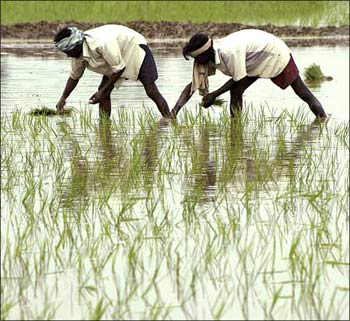

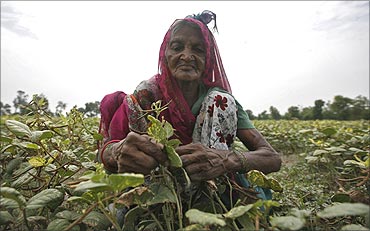
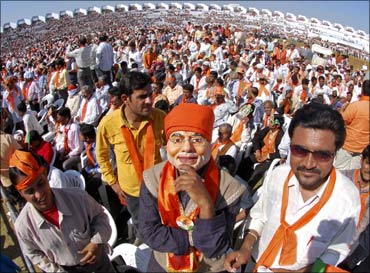

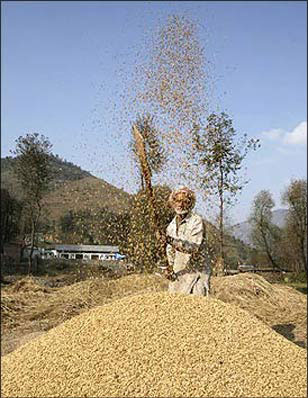
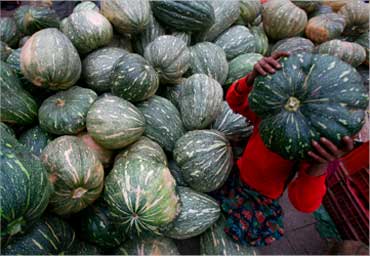

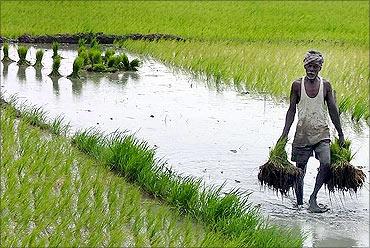

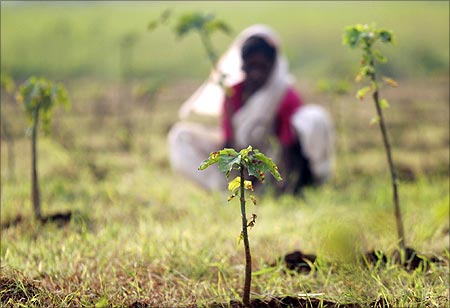

article